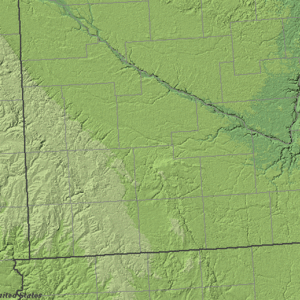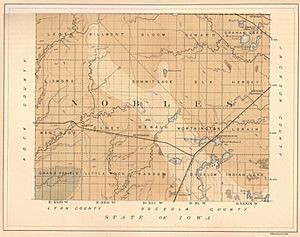Buffalo Ridge facts for kids
Buffalo Ridge is a long area of rolling hills in southwestern Minnesota. It's part of a bigger highland region called the Coteau des Prairies. This ridge stands about 1,995 feet (608 meters) above sea level, making it quite high.
Buffalo Ridge stretches for about 60 miles (97 km). It goes through several counties in Minnesota: Lincoln, Pipestone, Murray, Nobles, and Rock.
Because Buffalo Ridge is so high and often has strong winds, it's a great place to create clean energy. Many wind turbines have been built here to capture the wind's power. By 2006, there were over 200 wind turbines in the area.

Contents
How Buffalo Ridge Was Formed
Buffalo Ridge sits on a drainage divide. This means it's a high point that separates where water flows. Rain that falls on one side of the ridge will flow into the Mississippi River. Rain on the other side will flow into the Missouri River.
This ridge is the highest point of the Coteau des Prairies in Minnesota. Its base rock is made of Cretaceous shale, sandstone, and clay. These layers sit on top of a very old, pinkish-red rock called Sioux Quartzite.
Most of the ridge is covered by thick layers of glacial till. This is a mix of rock and dirt left behind by ancient glaciers. Some areas have up to 800 feet (244 meters) of this glacial material!
On top of the glacial deposits, there's a layer of wind-blown silt called loess. This layer is usually 6 to 15 feet (1.8 to 4.6 meters) thick. Loess creates the long, gently sloping hills you see today. Because loess can be easily washed away, there aren't many lakes or wetlands here. Instead, water flows into well-formed river systems that lead to the Missouri River and Minnesota River.
The soils on Buffalo Ridge are mostly rich, well-drained soils called loamy soils. These soils, along with the mild climate, were perfect for growing tallgrass prairie. This type of prairie once covered almost all of Buffalo Ridge.
Weather and Climate
Buffalo Ridge has a mid-latitude continental climate. This means it has warm summers and cold winters. It gets about 24 to 27 inches (0.6 to 0.7 meters) of rain each year. In winter, it usually gets 36 to 40 inches (0.9 to 1.0 meters) of snow.
Spring usually arrives around April 5, and plants start to turn green between May 1 and May 10. The leaves change color in the fall around October 20. The area also experiences about 40 to 50 thunderstorms each year.
The Powerful Chandler-Lake Wilson Tornado of 1992
On June 16, 1992, very strong storms hit parts of South Dakota and southwestern Minnesota. These storms created several large and powerful tornadoes.
One of the strongest tornadoes formed near a small town called Leota in southwestern Minnesota. This tornado quickly grew to be about 0.75 miles (1.2 km) wide. It stayed on the ground for almost an hour and a half! This powerful storm caused a lot of damage in the towns of Chandler and Lake Wilson.
This tornado was given the highest rating on the Fujita Scale, an F5. This means it was an incredibly strong tornado. It was the only F5 tornado recorded in the United States that year. Later that day, another tornado formed and hit Chandler a second time.
The Land and Its People
Before settlers arrived and built towns, the Dakota Native Americans lived in the Buffalo Ridge area. They, and other tribes before them, used a special type of claystone found here called "Catlinite." They carved beautiful and detailed pipes from this stone. These pipes are now displayed at Pipestone National Monument. Even today, Native Americans from all over the country still come to this area to quarry this stone for pipe-making.
Most of the land on Buffalo Ridge is now privately owned farmland.
Hole in the Mountain Prairie
Hole in the Mountain Prairie is a special nature reserve. It was created by The Nature Conservancy to protect the shrinking tallgrass prairie and the insects and animals that live there. This reserve is on the edge of Buffalo Ridge and is where Flandreau Creek begins.
In the past, this area was used for grazing cattle and sheep. This nearly caused the tallgrass prairie to disappear. Today, The Nature Conservancy helps the prairie recover by using controlled burning. This method has helped the native prairie plants grow back wonderfully.
Wind Energy Farms
Because of its strong winds, Buffalo Ridge is home to many wind farms. These farms have many wind turbines that generate electricity from the wind. Some of the wind farms located here include Nobles Wind Farm, Buffalo Ridge Wind Farm, and Fenton Wind Farm.



